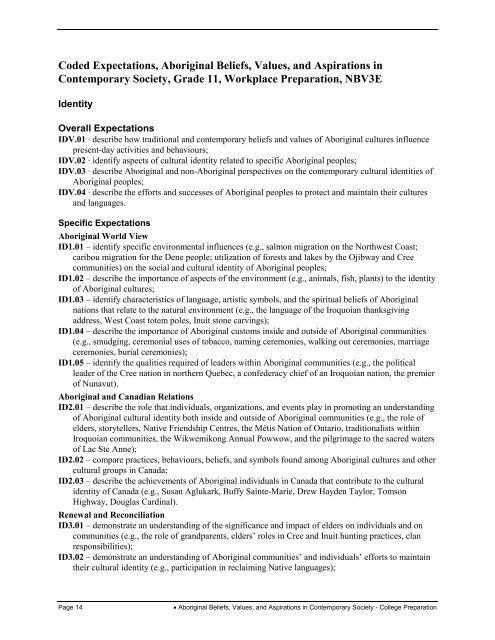Aboriginal Beliefs, Values, and Aspirations in Contemporary Society
Aboriginal Beliefs, Values, and Aspirations in Contemporary Society
Aboriginal Beliefs, Values, and Aspirations in Contemporary Society
Create successful ePaper yourself
Turn your PDF publications into a flip-book with our unique Google optimized e-Paper software.
Coded Expectations, <strong>Aborig<strong>in</strong>al</strong> <strong>Beliefs</strong>, <strong>Values</strong>, <strong>and</strong> <strong>Aspirations</strong> <strong>in</strong><br />
<strong>Contemporary</strong> <strong>Society</strong>, Grade 11, Workplace Preparation, NBV3E<br />
Identity<br />
Overall Expectations<br />
IDV.01 · describe how traditional <strong>and</strong> contemporary beliefs <strong>and</strong> values of <strong>Aborig<strong>in</strong>al</strong> cultures <strong>in</strong>fluence<br />
present-day activities <strong>and</strong> behaviours;<br />
IDV.02 · identify aspects of cultural identity related to specific <strong>Aborig<strong>in</strong>al</strong> peoples;<br />
IDV.03 · describe <strong>Aborig<strong>in</strong>al</strong> <strong>and</strong> non-<strong>Aborig<strong>in</strong>al</strong> perspectives on the contemporary cultural identities of<br />
<strong>Aborig<strong>in</strong>al</strong> peoples;<br />
IDV.04 · describe the efforts <strong>and</strong> successes of <strong>Aborig<strong>in</strong>al</strong> peoples to protect <strong>and</strong> ma<strong>in</strong>ta<strong>in</strong> their cultures<br />
<strong>and</strong> languages.<br />
Specific Expectations<br />
<strong>Aborig<strong>in</strong>al</strong> World View<br />
ID1.01 – identify specific environmental <strong>in</strong>fluences (e.g., salmon migration on the Northwest Coast;<br />
caribou migration for the Dene people; utilization of forests <strong>and</strong> lakes by the Ojibway <strong>and</strong> Cree<br />
communities) on the social <strong>and</strong> cultural identity of <strong>Aborig<strong>in</strong>al</strong> peoples;<br />
ID1.02 – describe the importance of aspects of the environment (e.g., animals, fish, plants) to the identity<br />
of <strong>Aborig<strong>in</strong>al</strong> cultures;<br />
ID1.03 – identify characteristics of language, artistic symbols, <strong>and</strong> the spiritual beliefs of <strong>Aborig<strong>in</strong>al</strong><br />
nations that relate to the natural environment (e.g., the language of the Iroquoian thanksgiv<strong>in</strong>g<br />
address, West Coast totem poles, Inuit stone carv<strong>in</strong>gs);<br />
ID1.04 – describe the importance of <strong>Aborig<strong>in</strong>al</strong> customs <strong>in</strong>side <strong>and</strong> outside of <strong>Aborig<strong>in</strong>al</strong> communities<br />
(e.g., smudg<strong>in</strong>g, ceremonial uses of tobacco, nam<strong>in</strong>g ceremonies, walk<strong>in</strong>g out ceremonies, marriage<br />
ceremonies, burial ceremonies);<br />
ID1.05 – identify the qualities required of leaders with<strong>in</strong> <strong>Aborig<strong>in</strong>al</strong> communities (e.g., the political<br />
leader of the Cree nation <strong>in</strong> northern Quebec, a confederacy chief of an Iroquoian nation, the premier<br />
of Nunavut).<br />
<strong>Aborig<strong>in</strong>al</strong> <strong>and</strong> Canadian Relations<br />
ID2.01 – describe the role that <strong>in</strong>dividuals, organizations, <strong>and</strong> events play <strong>in</strong> promot<strong>in</strong>g an underst<strong>and</strong><strong>in</strong>g<br />
of <strong>Aborig<strong>in</strong>al</strong> cultural identity both <strong>in</strong>side <strong>and</strong> outside of <strong>Aborig<strong>in</strong>al</strong> communities (e.g., the role of<br />
elders, storytellers, Native Friendship Centres, the Métis Nation of Ontario, traditionalists with<strong>in</strong><br />
Iroquoian communities, the Wikwemikong Annual Powwow, <strong>and</strong> the pilgrimage to the sacred waters<br />
of Lac Ste Anne);<br />
ID2.02 – compare practices, behaviours, beliefs, <strong>and</strong> symbols found among <strong>Aborig<strong>in</strong>al</strong> cultures <strong>and</strong> other<br />
cultural groups <strong>in</strong> Canada;<br />
ID2.03 – describe the achievements of <strong>Aborig<strong>in</strong>al</strong> <strong>in</strong>dividuals <strong>in</strong> Canada that contribute to the cultural<br />
identity of Canada (e.g., Susan Aglukark, Buffy Sa<strong>in</strong>te-Marie, Drew Hayden Taylor, Tomson<br />
Highway, Douglas Card<strong>in</strong>al).<br />
Renewal <strong>and</strong> Reconciliation<br />
ID3.01 – demonstrate an underst<strong>and</strong><strong>in</strong>g of the significance <strong>and</strong> impact of elders on <strong>in</strong>dividuals <strong>and</strong> on<br />
communities (e.g., the role of gr<strong>and</strong>parents, elders’ roles <strong>in</strong> Cree <strong>and</strong> Inuit hunt<strong>in</strong>g practices, clan<br />
responsibilities);<br />
ID3.02 – demonstrate an underst<strong>and</strong><strong>in</strong>g of <strong>Aborig<strong>in</strong>al</strong> communities’ <strong>and</strong> <strong>in</strong>dividuals’ efforts to ma<strong>in</strong>ta<strong>in</strong><br />
their cultural identity (e.g., participation <strong>in</strong> reclaim<strong>in</strong>g Native languages);<br />
Page 14<br />
• <strong>Aborig<strong>in</strong>al</strong> <strong>Beliefs</strong>, <strong>Values</strong>, <strong>and</strong> <strong>Aspirations</strong> <strong>in</strong> <strong>Contemporary</strong> <strong>Society</strong> - College Preparation
















